
Magura 2012
It seems that I have become a regular attendee at Magura’s yearly press camp held in Sedona, Arizona. I think this was my 4th (or 5th?) year at their press camp, and once again it didn’t disappoint. The headline act and host of the camp hasn’t had a product that is completely brand new in the last few years, and prior to the camp I was worried that I might be getting a bit stale with the reports coming back from the event. I’m not implying that Magura has been sitting on their laurels during these last few years – there have been many incremental changes to products and designs, as well as restructuring within the company. This year I was happy to discover there had been a lot going on behind the closed doors of Magura’s facility in Bad Urach, Germany.
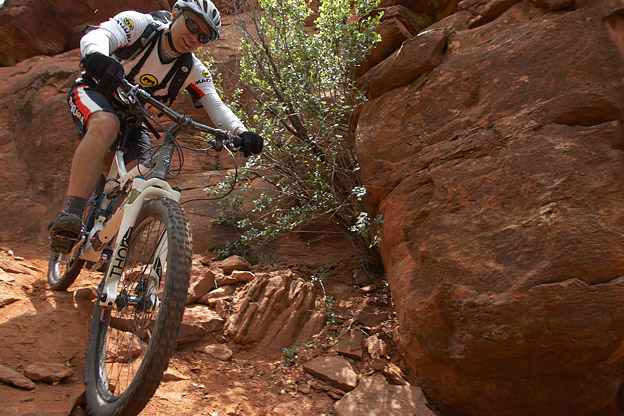
Stefan Pahl entering the steep chute near the end of Skyline, my favourite trail in Sedona. Stefan is the product manager for the bicycle components division and was responsible for laying out the criteria the MT brake series was to meet.
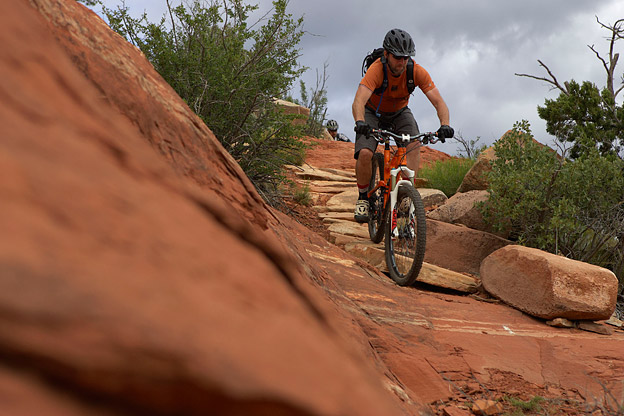
Brice Minnigh from Bike magazine negotiating some of the fun bits on Highline
While preparing to write this article, I was reviewing the report from last year’s press camp. Two words jumped out at me as soon as I started scanning that report: “Mission Performance”. Suddenly I remembered the website Stefan had made numerous references to last year, and the count-down clock on the website that would have reached zero sometime this past December. Had I remembered this during the winter, I would have checked in at that site to see what all the fuss was about; to see the mystical new product behind the bold sentence “We are going to make the world’s best disc brake for bikes”. If you’ve been out of the mountain bike media loop for a while, join me in our first look at the Magura MT8, and we’ll see if it has the potential to live up to the expectations of Magura’s marketing department.
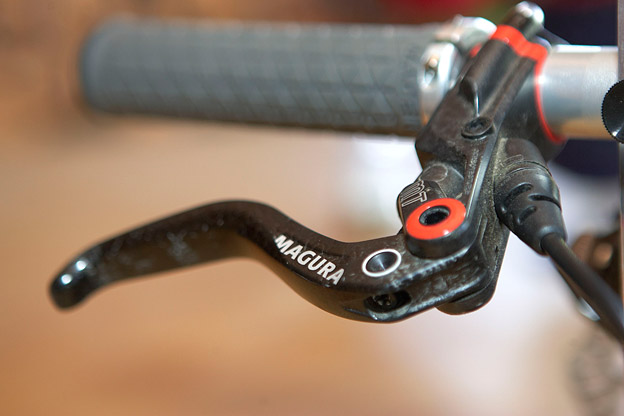
The new Magura MT8, made from an injection moulded carbon fibre and thermo plastic matrix Magura is calling Carbotecture.
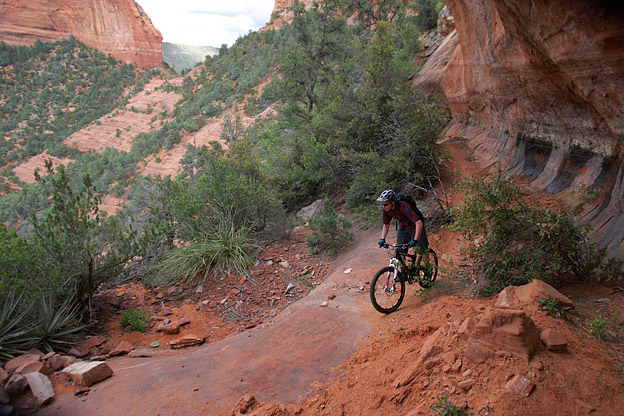
Mike Levy on Hangover. Part of this trail runs for a while along a ledge lined with trees and bushes that do a great job of concealing the exposure to the riders right.
With the birth of the MT series, Magura has put the old brake family to rest. The production line for Marta was shut down in December, followed later by Judy (the most popular product with the OEM market). Part of the new MT system was released a year ago – the Storm rotor. However, it was a year before that when Magura set out to design the MT series brake. An entire year of that two year process was devoted to engineering the right materials with which to build the master body. The end result is what Magura has called Carbotecture, of which there are two different flavours depending on the model. Carbotecture SL is a mixture of mid-length carbon fibre and thermo plastic bonded together with a type of resin also used in aircraft window frames. The non-SL version uses a mixture of shorter length carbon fibre and glass fibre. Magura has been in the injection-molding business since 1957, so it’s no surprise that they’ve mastered the process of creating these injection-molded parts. The resulting master body is the lightest and strongest they’ve ever produced, claimed to be nearly twice as strong as aluminum, magnesium and even carbon laminates. How light is light? The Marta master cylinder was 48 grams. Their old carbon master cylinder was 32 grams. The MT8 weighs in at a super light 20 grams.
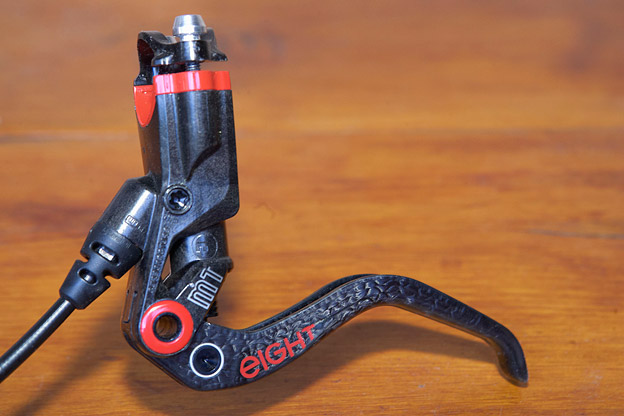
A carbon fibre blade, Carbotecture SL master cylinder, 6 brake bolts, 2 clamp bolts, 160mm Storm rotor and brake line add up to 277 grams.
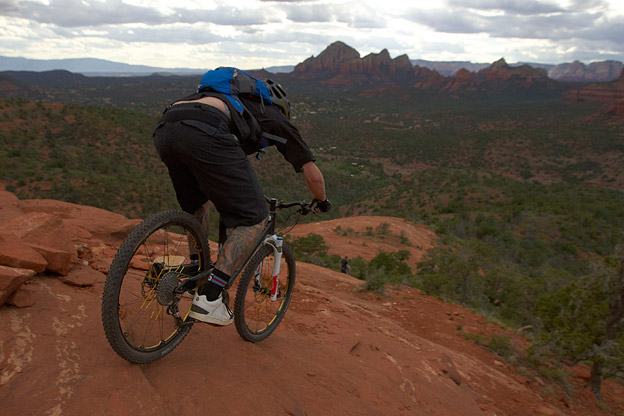
Drew Rohde employing some good brake modulation as he rolls down some slick rock on part of Hangover.
Within the MT series are four different models: the MT8, MT6, MT4 and MT2. At the top of the class, the MT8 is most likely intended for the cross country crowd who are ultra conscious with component weight, although the stopping power across the range is reported to be equal. The master body of the MT8 uses Carbotecture SL, has a carbon fibre blade and carbon fibre split clamp for mounting on your bars. The MT6 also uses Carbotecture SL, but swaps the carbon blade with an alloy blade and likewise with the clamp, and is intended for the FR market. MT4 uses Carbotecture (the non-SL variety) with alloy blade and clamp, as does the MT2. All brakes continue to use Magura’s easy-bleed technology (EBT). The MT8 and MT6 blades pivot on a hollow-axle, and have a reach adjustment with a longer range than previous years (and require a torx driver to adjust). Bite Adjustment Technology (BAT) introduced a few years ago is a second ergonomic adjustment available only on the MT4 model.
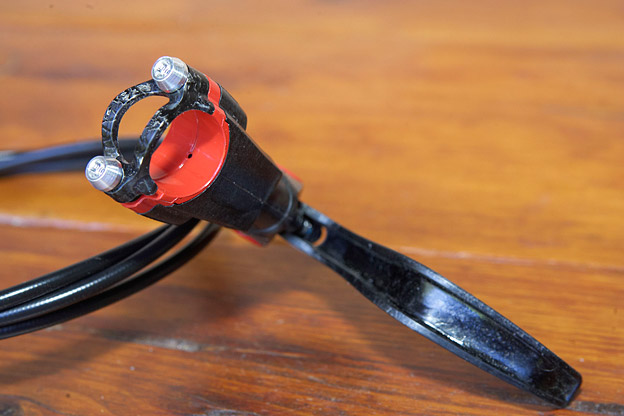
The carbon fibre split-clamp on the MT8. All models use a split clamp, but only the MT8 uses carbon for the clamp.
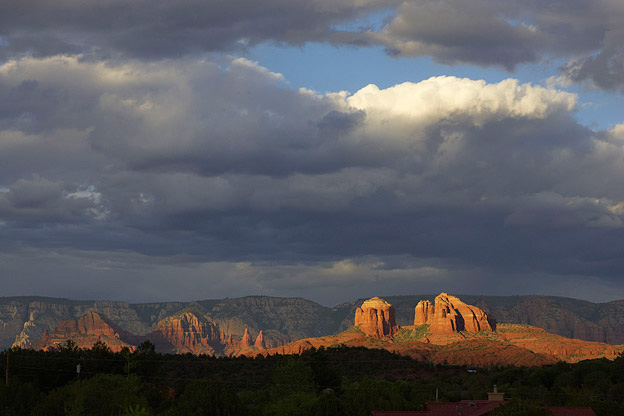
An evening view from the huge vacation rental home we all stayed in (for the long-time readers, it’s the same house that has the giant crystal in the floor of the living room)
Paired with the new master body is a brand new calliper. There are a few differences between the callipers within the model range. Cold-forged single piece aluminum callipers are used for the 8, 6 and 4. The MT2 uses a die-casted 2 piece aluminum calliper. All four of the callipers took a page from the books of Magura’s fork lineup by employing a double-arch design for maximum stiffness. Stefan described the internals of the calliper by making reference to a list of what Magura calls “anti-features”. These include anti-squeal, anti-heat, and anti-drag. He wouldn’t go into details on how the anti-squeal works, but did mention that organic pads are preferred over sintered pads. Anti-heat works by keeping as much heat in the rotor, shielded away from the calliper as much as possible. The pistons are made from a dura-plastic which has a very high heat tolerance and does not melt. They’re held in place by magnets which stick to a metal back-plate in the housing. The magnetic material is injected in the mold with the dura-plastic, a process not possible with ceramic pistons. Finally, the anti-drag refers to piston retraction in the housing. A special coating that acts as a lubricant is applied to the outside of the piston which prevents long-term sticking issues with piston movement.
As per usual, the Magura brakes use mineral oil rather than dot3 because mineral oil will not take on water over time. Water in the system can boil, which creates gas and subsequently a spongy feeling at the blade. A substantial part of the weight savings from the master body was intentionally used up by extra material in the calliper, adding strength, stiffness and better heat dissipation.
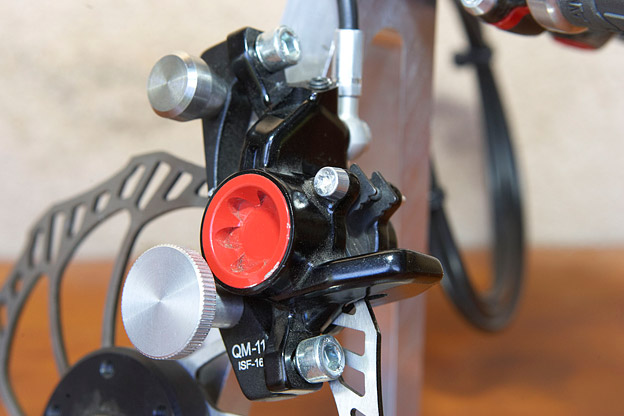
The new MT8 calliper mounted on a display stand.
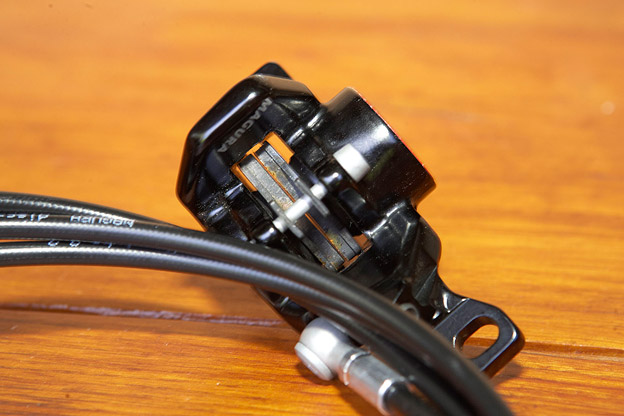
Looking down between the pads. Note the banjo style connector for the brake line, allowing for some extra mounting flexibility.
Rotor sizes available for the MT8 and MT6 are the standard 203mm, 160mm and 140mm. For the MT4 and MT2, 203mm and 160mm are available. The MT8 should be available by the time this report goes online, and will retail for $399 USD. The MT6 is due in July at $299, while the MT4 ($199) and MT2 ($129) are scheduled for release by the time Interbike (mid-September) rolls around. We’ll be doing a longer term test with some MT8’s so stay tuned for that. In the meantime, I’m happy to report that the MT8’s I used in Sedona worked very well.
There are a lot of variables to be dealt with when riding foreign trails on a foreign bike with a different suspension setup and riding characteristics. As I was paying attention to all of these things during the rides, it dawned on me that aside from my initial adjustment to the position of the brake on the handle bar (and blade reach), I had not thought once about the brakes. The trails have some sick lines down exposed slick rock, or loose Sedona red-dirt down some steep chutes and other super fun technical descents. In other words, sections that require some love from the brakes. Modulating the MT8’s quickly became a natural extension of my brain which is why I never had to think about them. I did not experience any fade, but some long term testing up at Whistler will be a better place to see how the new design copes with a lot of hard braking.
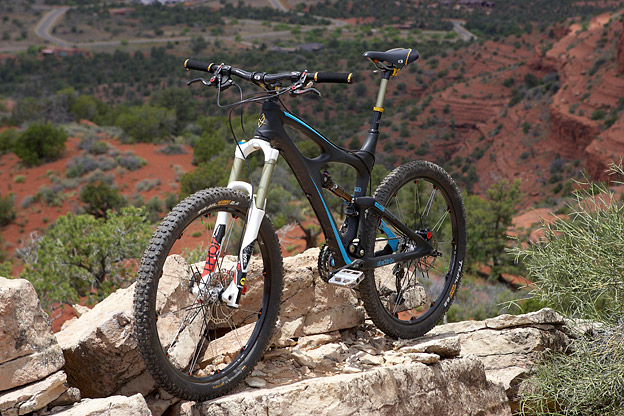
My ride for the event was the new 2012 Ibis Mojo SLR, equipped with a Shimano drivetrain, Fox Float RP23, Continental Trail King tires, and Crank Bros Iodine 2.0 all mountain wheels. The 2012 Mojo SLR has been redesigned from the ground up. The all-mountain bike has a full carbon monocoque frame and swingarm with a dw-link suspension, and was fully capable on the trails of Sedona.
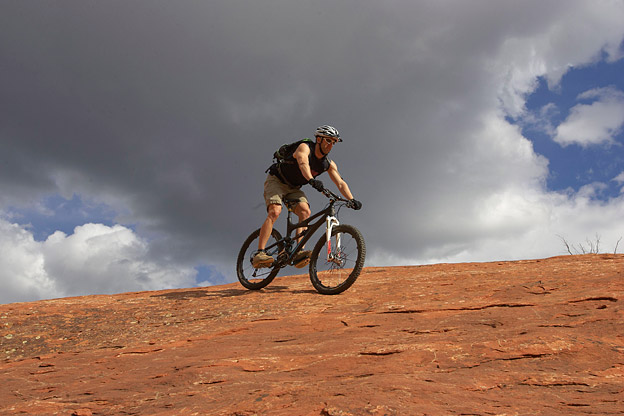
Yours truly dropping into the start of Hangover on some off-camber exposed slick rock. Photo courtesy Mr. Levy.
Handling the duty upfront on my Mojo was the new 2012 Thor 150mm fork. If you’re not very familiar with Magura’s fork lineup, Thor is their heavy-hitter, classified as an all-mountain fork. The other models are all xc and xc race specific, as Magura does not make a DH specific fork. Thor has been evolving over the years in a way that I think could satisfy the needs of a typical weekend Shore rider. I would have been hesitant to put all of my trust in Thor a few model years back (on the trails in our Vancouver back yard), but that’s no longer the case. It feels very strong and solid, thanks in part to the dual-arch design (DAD) and a 15mm Maxle. The stanchions are 32mm in diameter, and a tapered steerer tube is standard.
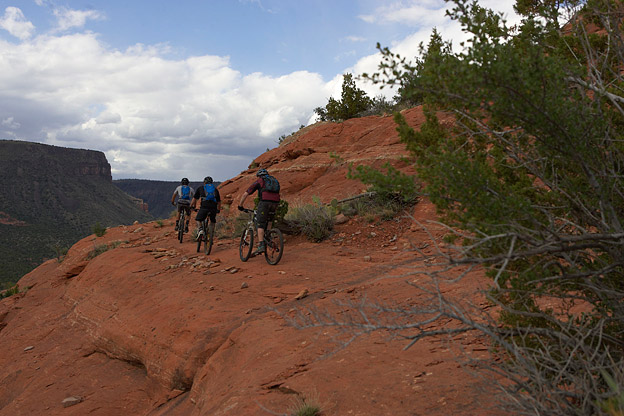
Making our way down some of the (super grippy) slick rock on Hangover.
Aside from an increase of 10mm in travel from last year, all of the changes for 2012 are internal. Switching to grease for lubrication (2g per lower leg rather than 5cc of oil) has allowed the use of non-slotted bushings, providing more surface contact on the stanchions. Thor uses an updated damping system called DLO2, or Dynamic LockOut (version 2) that replaces the older DLO system. DLO can be engaged by an external on/off adjustment dial on the top of the right leg. When it’s on, the fork will sag into 20% of its travel by way of a very small pin-hole in one of the shims that allows the oil to slowly move through, but still offers a firmness on higher speed bumps because the oil can not move through the pin hole at a high rate. The fork will use the negative travel of that 20% sag if the pressure causing the sag is lightened. Thor does a better job of staying high in its travel on low speed compression with revamped compression valving, leaving the rider with enough travel left in the fork when rolling off ledges on steep descents (for example). A lower-volume air chamber fixes previous complaints of a linear feeling travel, the fork now ramps up near the end of its travel. I think this change alone makes the fork feel completely different than last year’s model.
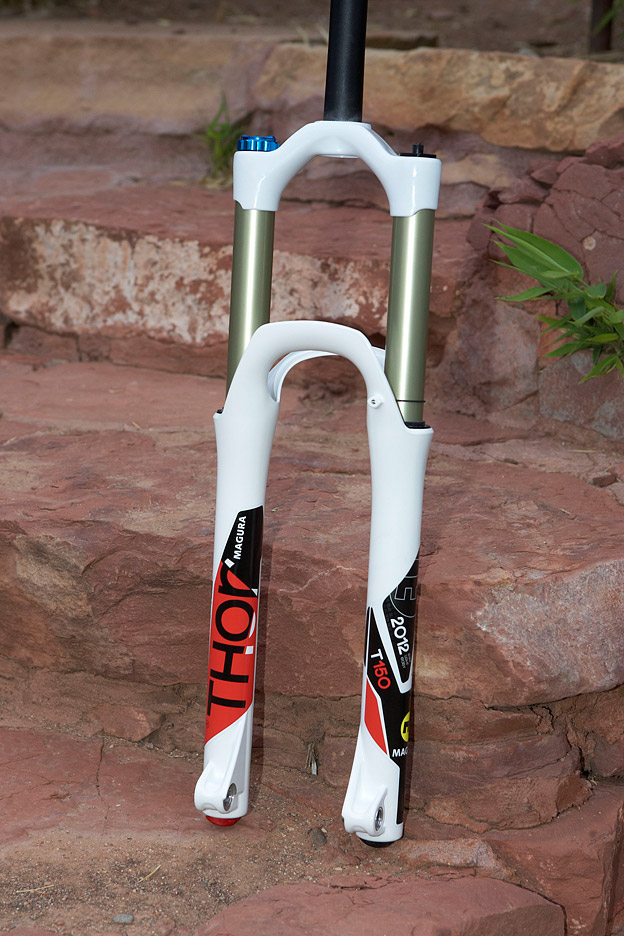
The 2012 Thor, 150mm. A 140mm version will be available, and travel can also be adjusted internally. The blue dial on the top is the Dynamic LockOut engagement. Price: $899 – $939 USD. Weight starts at 1750g.
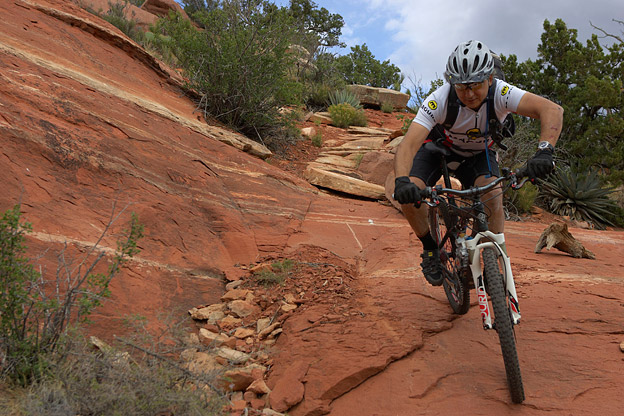
Jude Monica, Technical Services Manager for Magura. Technical bike rider too.
Only two external adjustments are standard on the Thor: rebound damping and air pressure. Magura believes simpler is better, setting out to design a fork that is easy to setup (make sure the air pressure is correct according to the chart on the back of the fork, and off you go!) and easy to tear down and service. Only 4 tools are needed to completely disassemble the fork, and the oil stays inside of its chamber in the stanchion so it’s possible to pull the fork apart without needing to deal with the oil.
Testing the Thor on the red rock trails revealed a fork that hits the mark pretty well in all of the areas Magura set out to achieve. It’s quick and light feeling thanks to its structural stiffness. DLO worked well when climbing, I had fewer incidents of losing my front wheel traction on some familiar technical ascents that had previously caused issues for me. I lost no confidence in any of the technical or steep descents, although I did use up all of the travel on a few occasions due to lower air pressure than I should have been using. Smaller high-frequency bumps while flowing flat sections posed no problems, Thor ate them up without much complaining. We are going to try to do a longer term test of the Thor here up North, so stay tuned.
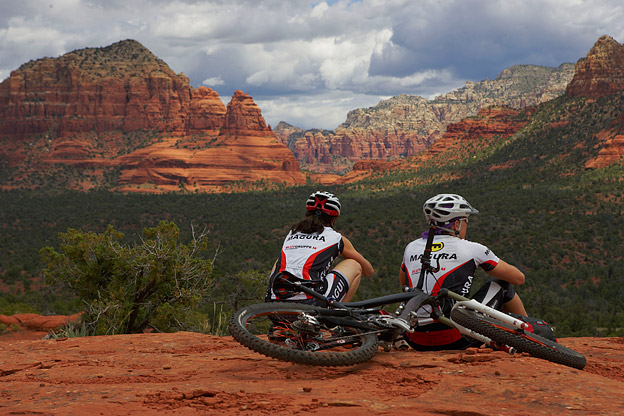
Ruthie Matthes and Paul Giarratano from Magura taking a moment to soak in some Sedona vistas
Riding in Sedona requires some lungs and some effort to earn the higher-altitude views and subsequent descents, but they’re well worth it. The landscape of red-rock mesas, desert shrub and cactus under a big blue sky is a welcome change from our beloved dense rain forest of the Southern BC coast line. There is an active community of riders and trail builders, a pair of whom were with us again for the press camp. John and Janet Finch are excellent tour guides, cooks and source of local knowledge. Not to mention John’s dry sense of humour. If you find yourself heading to Sedona, look up John and Janet and I’m sure they’d be more than happy to show you around. Make sure you point your tire towards Highline (my favourite trail) and Hangover for two excellent rides.
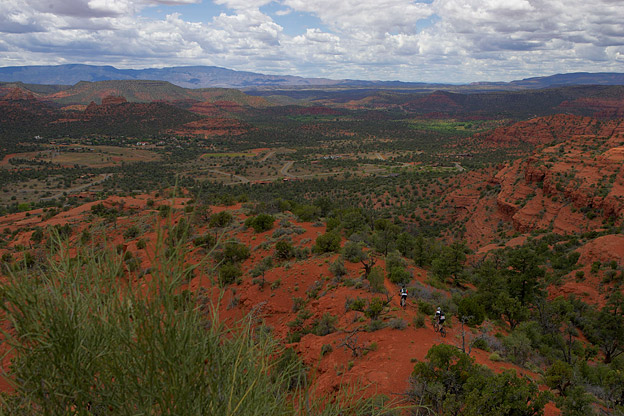
Two of the Magura boys on Highline
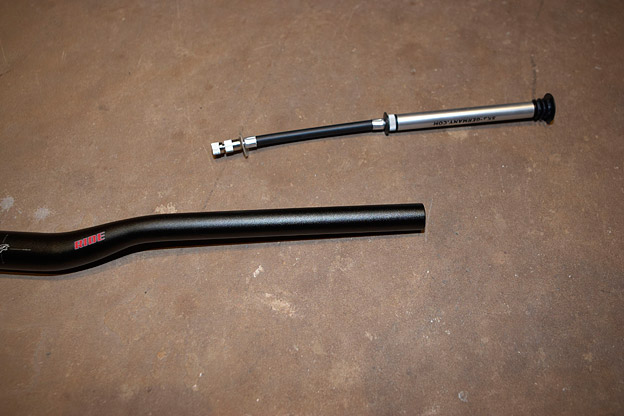
Now you see it…
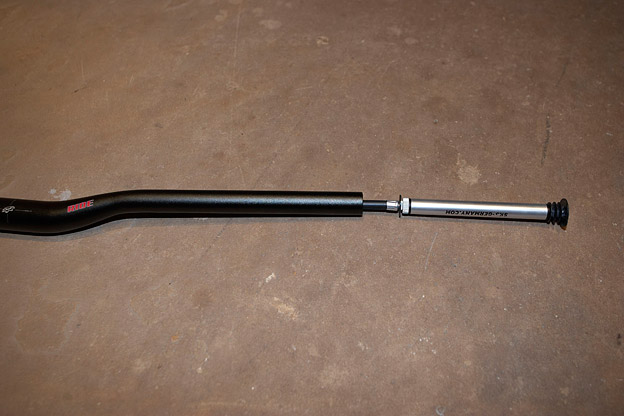
Now you don’t. This little pump from SKS (also in attendance at the camp) slides into your handle bar and stays there nice and snug without making any rattling noise on the bumpy stuff. Would you use it? Could be handy in a pinch..
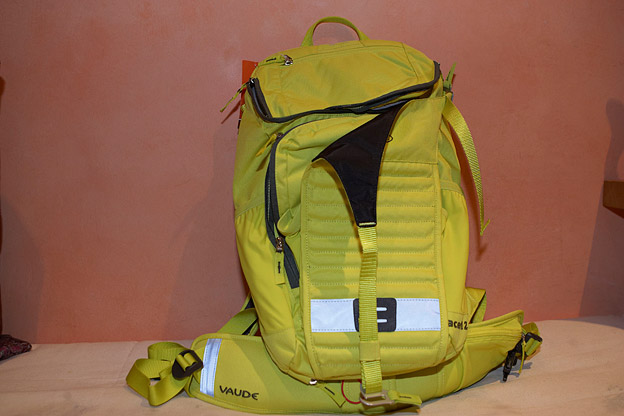
Vaude and Uvex both fall under Magura’s North American distribution umbrella. The Tracer 12, a new pack from Vaude features all of the bells and whistles you’d expect from a modern pack, plus a few extras.
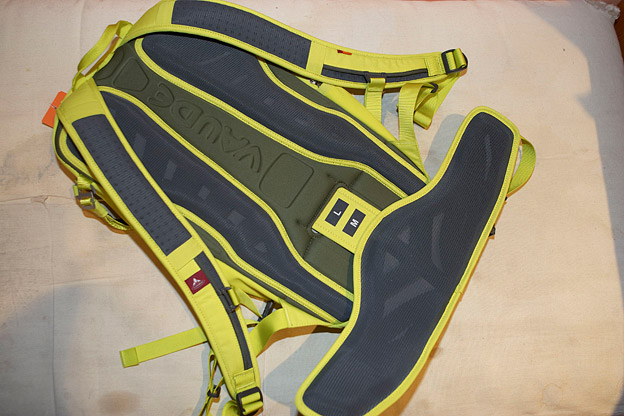
Every year, Vaude seems to improve on their fitting system for the packs. For example, it’s super easy to adjust the lumbar support position of this pack by pulling on a small hook to unlock the sliding waist strap.
Thank-you to everyone at Magura for putting up with us, and for putting us up. The trip to Sedona never disappoints, nor does the hospitality from everyone involved. The more I ride the trails in Sedona, the more they grow on me. I hope to be back next year.
Stay tuned later this season for a full report on both the MT8 and the new Thor after some testing on the local trails.
If you’ve read this far and have any questions or comments, head over to the forum…







Comments
Please log in to leave a comment.